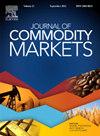绿色债券、清洁能源市场和碳配额价格之间的关联性:时间和频率动态
IF 4.5
4区 经济学
Q1 BUSINESS, FINANCE
引用次数: 0
摘要
在本文中,我们研究了绿色债券、清洁能源市场和碳价格等绿色资产之间联系的时间和频率动态。利用每日价格数据,我们采用 Baruník 和 Krehlík (2018 年)提出的时间和频率动态新框架,探讨了这些绿色金融市场的回报溢出效应。这使我们能够确定变量间溢出效应的方向,并分解关联性以区分短期和长期回报溢出效应。我们的结果表明,绿色债券和碳价格是冲击的净接收者,但主要是在短期内。我们还观察到,即使在经济或政治危机时期,清洁能源市场在低频段和高频段的关联度都很低。此外,在某些时期,清洁能源资产之间的联系是由长期因素驱动的。在经济和政治稳定时期,碳价格也可以为短期投资者提供有趣的多样化工具。我们的研究结果对于关注绿色金融市场的投资者和投资组合经理来说应该是有意义的,因为它强化了绿色金融市场可以为短期和长期投资者提供多样化机会的理念。决策者在制定短期和长期气候政策时,也可以从我们关于连带性的见解中获益。本文首次使用这一框架来研究绿色金融市场的系统性风险。本文章由计算机程序翻译,如有差异,请以英文原文为准。
Connectedness between green bonds, clean energy markets and carbon quota prices: Time and frequency dynamics
In this paper, we investigate the time and frequency dynamics of connectedness among green assets such as green bonds, clean energy markets, and carbon prices. Using daily price data, we explore return spillovers across these green financial markets by applying the novel framework on time and frequency dynamics proposed by Baruník and Krehlík (2018). This allows us to identify the direction of spillovers among our variables, and decompose the connectedness to differentiate between short-term and long-term return spillovers. Our results indicate that green bonds and carbon prices act as net receivers of shocks, but mainly in the short-term. We also observe a low level of connectedness among our clean energy markets across both low and high frequency bands, even during times of economic or political crisis. Additionally, there are periods in which connectedness between the clean energy assets is driven by the long-term. In periods of economic and political stability, carbon prices may also provide an interesting diversifying tool for short-term investors. Our results should be of interest for investors and portfolio managers who focus on green financial markets, by strengthening the notion that green financial markets can offer diversification opportunities, for both short-term and long-term investors. Policy makers could also benefit from our insights on conectedness in their work on short-term and long-term climate policies. This paper is the first to use this framework to investigate systematic risks within green financial markets.
求助全文
通过发布文献求助,成功后即可免费获取论文全文。
去求助
来源期刊

Journal of Commodity Markets
Multiple-
CiteScore
5.70
自引率
2.40%
发文量
53
期刊介绍:
The purpose of the journal is also to stimulate international dialog among academics, industry participants, traders, investors, and policymakers with mutual interests in commodity markets. The mandate for the journal is to present ongoing work within commodity economics and finance. Topics can be related to financialization of commodity markets; pricing, hedging, and risk analysis of commodity derivatives; risk premia in commodity markets; real option analysis for commodity project investment and production; portfolio allocation including commodities; forecasting in commodity markets; corporate finance for commodity-exposed corporations; econometric/statistical analysis of commodity markets; organization of commodity markets; regulation of commodity markets; local and global commodity trading; and commodity supply chains. Commodity markets in this context are energy markets (including renewables), metal markets, mineral markets, agricultural markets, livestock and fish markets, markets for weather derivatives, emission markets, shipping markets, water, and related markets. This interdisciplinary and trans-disciplinary journal will cover all commodity markets and is thus relevant for a broad audience. Commodity markets are not only of academic interest but also highly relevant for many practitioners, including asset managers, industrial managers, investment bankers, risk managers, and also policymakers in governments, central banks, and supranational institutions.
 求助内容:
求助内容: 应助结果提醒方式:
应助结果提醒方式:


